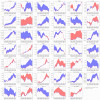A Markovian model of evolving world input-output network
- PMID: 29065145
- PMCID: PMC5655482
- DOI: 10.1371/journal.pone.0186746
A Markovian model of evolving world input-output network
Abstract
The initial theoretical connections between Leontief input-output models and Markov chains were established back in 1950s. However, considering the wide variety of mathematical properties of Markov chains, so far there has not been a full investigation of evolving world economic networks with Markov chain formalism. In this work, using the recently available world input-output database, we investigated the evolution of the world economic network from 1995 to 2011 through analysis of a time series of finite Markov chains. We assessed different aspects of this evolving system via different known properties of the Markov chains such as mixing time, Kemeny constant, steady state probabilities and perturbation analysis of the transition matrices. First, we showed how the time series of mixing times and Kemeny constants could be used as an aggregate index of globalization. Next, we focused on the steady state probabilities as a measure of structural power of the economies that are comparable to GDP shares of economies as the traditional index of economies welfare. Further, we introduced two measures of systemic risk, called systemic influence and systemic fragility, where the former is the ratio of number of influenced nodes to the total number of nodes, caused by a shock in the activity of a node, and the latter is based on the number of times a specific economic node is affected by a shock in the activity of any of the other nodes. Finally, focusing on Kemeny constant as a global indicator of monetary flow across the network, we showed that there is a paradoxical effect of a change in activity levels of economic nodes on the overall flow of the world economic network. While the economic slowdown of the majority of nodes with high structural power results to a slower average monetary flow over the network, there are some nodes, where their slowdowns improve the overall quality of the network in terms of connectivity and the average flow of the money.
Conflict of interest statement
Figures









References
-
- Markov AA. Rasprostranenie zakona bol’shih chisel na velichiny, zavisyaschie drug ot druga. Izvestiya Fiziko-matematicheskogo obschestva pri Kazanskom universitete. 1906;15(135–156):18.
-
- Page L, Brin S, Motwani R, Winograd T. The PageRank citation ranking: bringing order to the web.
-
- Bengio Y, Courville A, Vincent P. Representation learning: A review and new perspectives. IEEE transactions on pattern analysis and machine intelligence. 2013. August;35(8):1798–828. doi: 10.1109/TPAMI.2013.50 - DOI - PubMed
-
- Langville AN, Meyer CD. Google's PageRank and beyond: The science of search engine rankings Princeton University Press; 2011. July 1.
-
- Levene M, Loizou G. Kemeny's constant and the random surfer. The American mathematical monthly. 2002. October 1;109(8):741–5.
MeSH terms
LinkOut - more resources
Full Text Sources
Other Literature Sources

